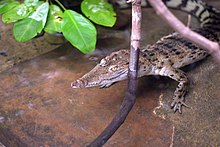Philippines crocodile
| Philippines crocodile | ||||||||||||
|---|---|---|---|---|---|---|---|---|---|---|---|---|

|
||||||||||||
| Systematics | ||||||||||||
|
||||||||||||
| Scientific name | ||||||||||||
| Crocodylus mindorensis | ||||||||||||
| Schmidt , 1935 |
The Philippines crocodile ( Crocodylus mindorensis ) is a species of the real crocodiles (Crocodylidae). The species is threatened with extinction.
features
Compared to all other crocodiles in the Pacific region, the Philippines crocodile is characterized by a very wide snout, which is reinforced with up to 68 teeth, and large armored scales in the neck and back area.
With a maximum body length of three meters in males, it is one of the smaller crocodile species. The females of this species are smaller, up to 1.5 meters and up to 15 kg in body weight. The behavior of the Philippines crocodile is described as shy and harmless towards humans, it only reacts aggressively when provoked.
distribution
The Philippines crocodile lives in fresh waters such as rivers, smaller lakes, and swamp areas. Its distribution is limited to individual islands in the Philippines . In historical times, the animals were found on the islands of Luzon , Mindoro , Masbate , Samar , Negros , Busuanga and Mindanao .
Its current distribution areas are limited to the Agusan marshland , the Ligawasan marshland and the upper reaches of the Pulangi in the province of Bukidnon on the island of Mindanao . On the island of Luzon , the Northern Sierra Madre Natural Park and areas in the province of Abra along the Binungan River are part of its current habitat. In 2005, the northernmost crocodile population found so far was found on Dalupiri Island . All other sightings could not be confirmed.
Way of life
Like most other crocodiles, the Philippines crocodile feeds on very different organisms in the water. Its spectrum probably includes snakes , frogs , water turtles , insects and small mammals , but the exact details are not known. The ratio between males to females in the populations is usually 1: 1.
The mating period varies depending on the distribution area, but is generally in the months of January to May. Especially at dawn between 4 and 7 o'clock, the procedure, which takes up to 30 minutes, can be observed, which takes place in the water.
A week before the eggs are laid, the females build a mound nest of sand and rotting plant material in which they deposit 7 to 25 eggs. The incubation period is approx. 12 weeks. Guarding of the nest and brood care were observed.
Danger
The Philippines crocodile is listed as critically endangered on the IUCN Red List . The total population is estimated to be 92-137 adults, which are divided into several subpopulations. The inventory trend continues to decline. The sharp decline is due to the trade in the hides, while habitat loss is currently the greatest threat.
supporting documents
- The Philippines crocodile at the Philippine Clearing House
- Merlijn van Weerd: Philippine Crocodile Crocodylus mindorensis ; Philippine Crocodile Group of the IUCN
literature
- Charles A. Ross (Ed.): Crocodiles and Alligators - Evolution, Biology and Distribution. Orbis Verlag, Niedernhausen 2002
- Joachim Brock: Crocodiles - A life with armored lizards. Natur und Tier Verlag, Münster 1998
Individual evidence
- ↑ CROCODILE SURVEYS ON DALUPIRI AND FUGA ( Memento of the original from June 20, 2015 in the Internet Archive ) Info: The archive link was inserted automatically and has not yet been checked. Please check the original and archive link according to the instructions and then remove this notice. (PDF; 499 kB) Authors: Carl Oliveros, Samuel Telan and Merlijn van Weerd Publication by Isla Biodiversity Conservation, Inc. and the Mabuwaya Foundation, Inc., July 2006
- ↑ Crocodilian Species - Philippine Crocodile (Crocodylus mindorensis). Retrieved April 7, 2020 .
- ^ Van Weerd, M., C. Pomaro, C., de Leon, J., Antolin, R. & Mercado, V .: IUCN Red List of Threatened Species: Philippine Crocodile. May 24, 2012, accessed April 7, 2020 .
Web links
- Crocodylus mindorensis in The Reptile Database
- Crocodylus mindorensis - HerpaWorld "
- Crocodylus mindorensis inthe IUCN 2013 Red List of Threatened Species . Listed by: Crocodile Specialist Group, 1996. Retrieved April 27, 2018.

